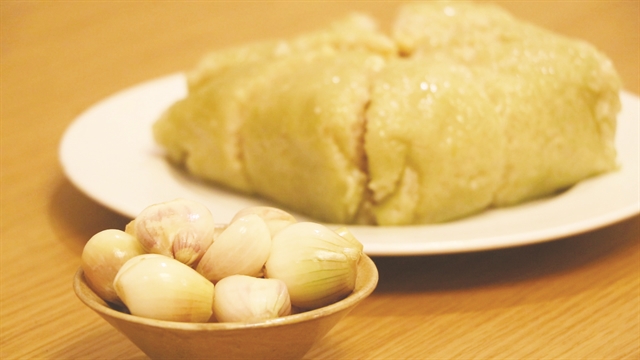
Pickled onions and chưng cake. - VNA Photo
By Đỗ Hữu
A Tết (Lunar New Year) feast is often a carefully prepared and extravagant event held to hope for a prosperous year. Together with bánh chưng (sticky rice cakes), thịt đông (jellied meat) and spring rolls, pickled onions are an integral part of the meal.
Most dishes exclusively associated with Tết are usually nutritious and can be preserved for longer those used in daily meals. Sometimes, eating too much meat and rich food can make people feel sick. Pickled onions can help in this case. The sour, fresh and low-calorie side dish is an ideal solution to ease the stomach and taste during the holiday.
Hà Nội-based Ứng Hồng Mai, 60, has maintained the tradition of pickling onions for many years.
“Some people make bánh chưng and other delicacies to preserve the tradition and create a Tết atmosphere for the family, and so do I,” she said.
“My family of three can eat six cakes and two kilos of onions during the week-long holiday.”
Mai starts preparing the first jars of onions two weeks before New Year’s Eve. She often divides the onions into two jars to make sure that the onions marinate perfectly in a mix of salt, sugar and vinegar.
“It’s not difficult to pickle onions but you still need some tips, even a slight mistake can ruin the whole batch,” said Mai.
In the north, people just peel the onions, but people in the south also cut the roots from the onions, according to Mai.
She always uses a terracotta jar, not plastic, because fermented food stored in plastic containers can be harmful.
Vietnamese pickled onions serve as a natural medicine for better digestion after high protein meals. The aromatic, crispy and sour taste of pickled onions goes with the fat jellied meat and tasty sticky rice cake served during the holiday.
“First, you choose onions that are hard and then off the sprouts, only keeping the bulbs. These onions are soaked in rice water for a night,” she said.
“After that, you clean the onions and cut them. Mix salt, rice vinegar and sugar in boiling water, then add to a jar full of onions.”
Mai shared that she always uses sugarcane to make the onions sweeter and reduce the acrid taste and smell. Every few days, she opens the jar and checks the pickling process.
After two weeks, the onions are ready to eat. If the onions are too sour, you can slice them into small pieces and dip them in soy sauce. That’s the way her family finish their jars of onions.
“People in the southern region often use purple onions for this dish. The weather in the south is always warmer than the north so it takes a shorter time for the pickled onions to sour,” said Mai.
Herbalist Hoàng Gia Trí said onions are great way improving the digestion.
“That’s the reason why many generations of Vietnamese people eat pickled onions with jellied meat and chưng cake,” he said.
“They can contain many probiotics that are good for people’s health,” he said. VNS
OVietnam